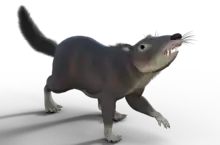Spinolestes
Spinolestes is an extinct mammal genus from the Early Cretaceous of Spain. A gobiconodontid eutriconodont, it is notable for the remarkable degree of preservation, offering profound insights to the biology of non-therian mammals.[1]
| Spinolestes | |
|---|---|
| Scientific classification | |
| Kingdom: | Animalia |
| Phylum: | Chordata |
| Class: | Mammalia |
| Order: | †Gobiconodonta |
| Family: | †Gobiconodontidae |
| Genus: | †Spinolestes Martin, 2015 |
| Species: | †S. xenarthrosus |
| Binomial name | |
| †Spinolestes xenarthrosus Martin, 2015 | |
Description
Spinolestes' holotype, MCCMLH30000A', hails from Las Hoyas, Spain. The living animal was about 24 centimeters long and weighted somewhere between 50 and 70 grams. As a Konservat-Lagerstätten specimen, it is famous for being remarkably well preserved, including not only the skeleton but also multiple soft tissues like fur, skin, internal organs and ears (both external and internal), a rarity among Mesozoic mammals. Besides soft-tissues, Spinolestes is also remarkable for its xenarthrous vertebrae, convergent with those of xenarthrans and to a lesser extent hero shrews.
Soft tissue
Hair is very well preserved, down to the cellular level; among fossil mammals it is among the best preserved.[1] Spinolestes' fur was similar to that of modern mammals, possessing coumpound hair follicles with primary and secondary hair. The guard hairs are proto-spines similar to those of modern spiny mice. In some places on the body, hairs appear to have broken off close to the skin and were discolored near the broken tip – possible signs of dermatophytosis, making it the first Mesozoic mammal with a clear record of a skin infection. Besides hair, Spinolestes also had keratinous scutes.
Uniquely among Mesozoic mammal fossils the internal organs are also preserved, deposits of iron marking the position of the liver and microscopic structures being interpreted as the bronchioles. These are separated by a curved line, assumed to be the thoracic diaphragm.
The ear is very well preserved. The external ear (pinnae) is fairly large and broad in a mouse-like fashion. The inner ear is also exceptionally preserved in the form of the Meckel's cartilage, which may be of extreme relevance in understanding the evolution of the mammalian ear.
Phylogeny
Features in the dention and post-cranial skeleton suggest that Spinolestes was a gobiconodontid eutriconodont.
Cladogram after Thomas Martin et all 2015:
| Eutriconodonta |
| |||||||||||||||||||||||||||||||||||||||||||||||||||||||||||||||||||||||||||||||||||||||||||||||||||||||||||||||||||||
Palaeobiology
Like most eutriconodonts, Spinolestes was animalivorous, probably an insectivore. It was a terrestrial animal with some adaptations for fossoriality, possessing strong forelimbs with large claws. This, alongside the convergent traits with xenarthrans may indicate that it was ecologically similar to modern anteaters, pangolins, echidnas, aardvark, aardwolf and numbat, feeding on colonial insects like ants and termites. If this is the case, it would be the second known Mesozoic mammal to pursue such a diet after Fruitafossor.
The presence of spines and scutes make Spinolestes one of the earliest armoured mammals known.
The evidence of dermatophytosis in the holotype sets the precedent that Mesozoic mammals, like modern species, were also vulnerable to fungal infections.
Ecology
The environment of Las Hoyas dates to the Barremian, and it was probably a tropical or subtropical wetland habitat, based on its vegetation: Bennettitales, Brachyphyllum, Pagiophyllum, Sphenolepis and Cupressinocladus conifers, Weitchselia reticulata, Montsechia vidali and several others. Various species of fish and aquatic invertebrates are also known.[2]
Crocodylomorphs are the most common tetrapod fossils, bearing a wide variety of species from familiar semi-aquatic species as well as terrestrial forms like gobiosuchids and atoposaurids, the latter probably having competed with mammals. Non-avian dinosaurs are present in the form of Pelecanimimus and Mantellisaurus, but the site is more notable for a variety of enantiornithe birds like Iberomesornis, Concornis and Eoalulavis.
Pterosaurs are represented by ornithocheirids, istiodactylids and the tapejarid Europejara.
References
- Thomas Martin, Jesús Marugán-Lobón, Romain Vullo, Hugo Martín-Abad, Zhe-Xi Luo & Angela D. Buscalioni (2015). A Cretaceous eutriconodont and integument evolution in early mammals. Nature 526, 380–384. doi:10.1038/nature14905
- Fossilworks: Las Hoyas





